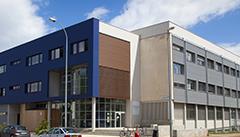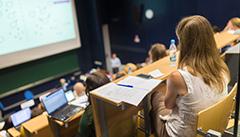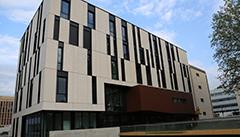
Sciences & Société
Soutenance de thèse : Jiging Huang
Virtual liver biopsy for Chronic liver disease monitoring by using mpMRI-based radiomic
Doctorant : Jiging Huang
Laboratoire INSA : CREATIS
Ecole doctorale : ED205 EDISS
Chronic liver disease (CLD) represents a broad spectrum of diseases involving different etiologies. These diseases are characterized by histological features such as inflammation, fibrosis, steatosis, ballooning, or iron overload. Among them, inflammation plays a critical role in the early liver fibrosis process, and fibrosis affects the CLD prognosis and treatment strategy. Although liver biopsy is the gold standard for the diagnosis of CLD, Its invasiveness limits its clinical use. Therefore, an alternative noninvasive, sensitive, and specific remains an unmet medical need.
Magnetic resonance imaging (MRI), especially with diffusion-weighted imaging (DWI) appears currently as an interesting imaging technique to detect CLD-related features. The objective of this thesis is to develop the concept of virtual biopsy to grade inflammation and fibrosis in CLD. To achieve this, the thesis is divided into two parts.
Firstly, using IVIM single sequence study, we studied the standard and advanced DWI’s parameters with different fitting approaches and diffusion models, and then the relationship between CLD- related features and DWI parameters were investigated. Significant differences were found between the groups with different degrees of fibrosis. The top four significant differences parameters were selected to build classifiers to characterize fibrosis.
Secondly, from multiple MRI sequences, a radiomics approach involving extraction of several feature combinations from conventional T1w or T2w images as well as proton density fat fraction, T2* and diffusion parameter maps was investigated. The best combinations were then searched to classify inflammation and fibrosis using random forest.
This study validated the utilization of multiparametric MRI for fibrosis and inflammation severity grading and proposed two effective classifiers for them.
Información adicional
-
Amphithéatre Chappe - Bâtiment Hedy Lamarr - Villeurbanne

Sciences & Société
Soutenance de thèse : Franck Nicolet
Emissions codées simultannées en synthèse d'ouverture pour l'imagerie ultrasonore
Doctorant : Franck Nicolet
Laboratoire INSA : CREATIS
Ecole doctorale : ED160 EEA
Dans sa forme conventionnelle, l’imagerie ultrasonore focalisée, la cadence d’image est limitée à quelques dizaines d’images par seconde. Durant les deux dernières décennies, l’imagerie ultrasonore a connu une véritable révolution avec l’apparition de l’imagerie dite ultrarapide, permettant d’imager avec une cadence d’image de plusieurs milliers d’images par seconde. Cette augmentation de la cadence d’image a permis l’émergence de nouveaux modes d’imagerie ultrasonores tels que l’imagerie fonctionnelle ou paramétrique, proposant de nouveaux outils de diagnostic pour les cliniciens. Cependant, toutes les méthodes d’imagerie ultrasonore ultrarapide souffrent d’un compromis entre cadence et qualité d’image.
Dans ce contexte, l’objectif principal de cette thèse est de développer des méthodes d’acquisition et de reconstruction d’images ultrasonore permettant d’optimiser la cadence d’image sans dégradation de la qualité. Pour cela, les émissions codées, dérivées des télécommunications et de l’imagerie RADAR, sont utilisées. L’axe principal de cette thèse concerne l’augmentation de la cadence d’image en imagerie ultrasonore par synthèse d’ouverture (STA). Classiquement, cette méthode d’imagerie permet d’atteindre une grande qualité d’image mais souffre d’une cadence d’image réduite. Le principe développé dans cette thèse consiste à activer simultanément plusieurs émetteurs en appliquant un encodage spatio-temporel à ces derniers. En utilisant cette méthode, nous montrons dans le chapitre V qu’un gain en cadence d’image d’un facteur 5 peut être atteint lors d’acquisitions expérimentales, sans dégradation de la qualité d’image. Un second axe investigué dans cette thèse consiste à augmenter la cadence d’image en imagerie par ondes planes (PWI) par l’émission simultanée de plusieurs ondes planes codées. Cet axe est décrit dans le chapitre VI. Un modèle direct est décrit et utilisé pour résoudre le problème inverse associé afin de reconstruire le milieu imagé. Dans ce chapitre, nous montrons que cette méthode permet d’améliorer simultanément la cadence et la qualité d’image lors d’acquisitions expérimentales.
Información adicional
-
Amphithéatre Chappe - Bâtiment Hedy Lamarr - Villeurbanne

Sciences & Société
Soutenance de thèse : Thibault DOUZON
Language Models for Document Understanding
Doctorant : Thibault DOUZON
Laboratoire INSA : LIRIS
Ecole doctorale : ED512 Informatique Et Mathématiques de Lyon
First used for natural language related tasks, language models can understand documents better than any previous statistical model, provided enough data for training and pre-training. This thesis proposes several architectures and training procedures to better model visually-rich documents. Its main findings are the data-afficiency of pre- trained transformers compared to recurrent neural networks, the importance of pre- training tasks for downstream performance, the introduction of pre-training tasks specific to business documents and alternative architectures to transformers for multi-page documents.
Información adicional
-
Amphithéâtre Chappe - Bâtiment Hedy Lamarr (Villeurbanne)

Sciences & Société
Soutenance de thèse : Youcef REMIL
A Data Mining Perspective on Explainable AIOps with Applications to Software Maintenance
Doctorant : Youcef REMIL
Laboratoire INSA : LIRIS
Ecole doctorale : ED512 Informatique Et Mathématiques de Lyon
La supervision des systèmes informatiques modernes est confrontée à des défis de scalabilité, de fiabilité et d'efficacité. Les approches traditionnelles de maintenance manuelle sont inefficaces, de même que les systèmes experts à base de règles pour gérer les alertes générées par les systèmes informatiques. AIOps for Operating Systems (AIOps) propose l'utilisation de techniques avancées d'apprentissage automatique centrées sur les données pour améliorer et automatiser la supervision des systèmes. Cependant, plusieurs défis doivent être relevés pour concrétiser cette vision. Le manque de terminologie claire et unifiée dans le domaine de l'AIOps rend difficile la progression et la comparaison des contributions. Les exigences et les métriques nécessaires à la construction de modèles AIOps alignés sur les contraintes industrielles ne sont pas suffisamment développées. Les contributions théoriques se sont principalement concentrées sur les modèles prédictifs, négligeant les défis liés à la qualité et à la complexité des données. La dépendance excessive aux modèles boîte noire opaques limite leur adoption par les praticiens de l'industrie. De plus, les solutions AIOps existantes accordent peu d'importance à l'évaluation des performances des modèles et aux problèmes de scalabilité. Nous proposons dans le cadre de cette thèse une approche systématique de l'AIOps en fournissant une catégorisation conforme aux normes industrielles. Nous explorons également la découverte de sous-groupes pour extraire des hypothèses intéressantes à partir de vastes ensembles de données diversifiées. Nos contributions dans cet axe de recherche comprennent l'identification de fragments de requêtes SQL suspects pour résoudre les problèmes de performance, un mécanisme d'interprétation pour les modèles de triage des incidents, et l'analyse des problèmes de saturation de mémoire Java caractérisé par un ensemble de données complexes intégrant des données hiérarchiques. Nous étudions également la scalabilité en se concentrant sur le problème de déduplication des incidents en se référant à la technique de hachage sensible à la localité.
Información adicional
-
Salle 501.337, Bâtiment Ada Lovelace (Villeurbanne)

Sciences & Société
Soutenance de thèse : Yoann JOVET
Sustainability of industrial heat decarbonisation strategies through 4E (energy, exergy, economic and environmental) optimisation
Doctorant : Yoann JOVET
Laboratoire INSA : CETHIL
Ecole doctorale : ED162 : Mécanique, Energétique, Génie Civil, Acoustique de Lyon
Ces travaux ont pour but d’évaluer la performance annuelle globale de différentes solutions de production de chaleur industrielle, par une méthode multicritère 4E (énergie, exergie, économie et environnement). Au-delà de cette évaluation, le travail proposé porte également sur le développement d’une méthode originale permettant de prendre en compte les limites planétaires dans la prise de décision visant à remplacer un moyen de production (généralement chaudières à gaz) par une solution moins carbonée.
L’atteinte de cet objectif a conduit au développement d’un modèle d’optimisation génétique multi- objectif original combinant critères technico-économiques et environnementaux, basés sur une approche par Analyse de Cycle de Vie (ACV). Afin d’être en mesure d’évaluer les transformations à l’échelle d’un secteur industriel, différents pays européens sont considérés sur trois périodes comprises entre 2015 et 2090 pour intégrer les évolutions de contraintes sur les émissions de GES et la disponibilité de technologies de capture et stockage de carbone (CCS). Une approche par regroupement (clustering) est proposée pour réduire l’étude à 100 pas de temps représentatifs de l’année afin de limiter le temps de calcul.
Une étude de sensibilité a été menée pour classer l’ensemble des solutions non-dominées trouvées par l’algorithme, aucune de ces solutions n’étant soutenable sur l’ensemble des critères environnementaux. Pour ce faire, trois approches d’évaluation sont proposées : R1 (Référence ACV de pondérations), R2 (pénalisation linéaire du dépassement des limites planétaires), et R3 (pénalisation exponentielle de ces limites et pénalisation du CCS).
Pour le classement R1, la technologie la plus performante est la pompe à chaleur, complétée par la chaudière biomasse quand le CCS devient suffisamment développé. Pour les méthodes R2 et R3, on observe des combinaisons de technologies qui dépendent du mix électrique : combinaison pompe à chaleur et chaudière gaz pour les mix majoritairement renouvelables ou chaudière biomasse pour les mix basés sur le nucléaire.
Información adicional
-
Amphithéâtre Clémence Royer (bâtiment Jacqueline Ferrand) - (Villeurbanne)

Sciences & Société
Soutenance de thèse : Youcef REMIL
A Data Mining Perspective on Explainable AIOps with Applications to Software Maintenance
Doctorant : Youcef REMIL
Laboratoire INSA : LIRIS
Ecole doctorale : ED512 Infomaths
La supervision des systèmes informatiques modernes est confrontée à des défis de scalabilité, de fiabilité et d'efficacité. Les approches traditionnelles de maintenance manuelle sont inefficaces, de même que les systèmes experts à base de règles pour gérer les alertes générées par les systèmes informatiques. AIOps for Operating Systems (AIOps) propose l'utilisation de techniques avancées d'apprentissage automatique centrées sur les données pour améliorer et automatiser la supervision des systèmes. Cependant, plusieurs défis doivent être relevés pour concrétiser cette vision. Le manque de terminologie claire et unifiée dans le domaine de l'AIOps rend difficile la progression et la comparaison des contributions. Les exigences et les métriques nécessaires à la construction de modèles AIOps alignés sur les contraintes industrielles ne sont pas suffisamment développées. Les contributions théoriques se sont principalement concentrées sur les modèles prédictifs, négligeant les défis liés à la qualité et à la complexité des données. La dépendance excessive aux modèles boîte noire opaques limite leur adoption par les praticiens de l'industrie. De plus, les solutions AIOps existantes accordent peu d'importance à l'évaluation des performances des modèles et aux problèmes de scalabilité. Nous proposons dans le cadre de cette thèse une approche systématique de l'AIOps en fournissant une catégorisation conforme aux normes industrielles. Nous explorons également la découverte de sous-groupes pour extraire des hypothèses intéressantes à partir de vastes ensembles de données diversifiées. Nos contributions dans cet axe de recherche comprennent l'identification de fragments de requêtes SQL suspects pour résoudre les problèmes de performance, un mécanisme d'interprétation pour les modèles de triage des incidents, et l'analyse des problèmes de saturation de mémoire Java caractérisé par un ensemble de données complexes intégrant des données hiérarchiques. Nous étudions également la scalabilité en se concentrant sur le problème de déduplication des incidents en se référant à la technique de hachage sensible à la localité.
Información adicional
-
Salle 501.337, Bâtiment Ada Lovelace (Villeurbanne)

Sciences & Société
Soutenance de thèse : Clément CAMBIER
Développement de revêtements et de la fonctionnalisation de surface des plaques bipolaires en titane
Doctorant : Clément CAMBIER
Laboratoire INSA : MatEiS
Ecole doctorale : ED 34 : Matériaux de Lyon
Ce travail a pour objectif l’étude du film passif des plaques bipolaires et le développement d’un revêtement original remplissant les spécifications techniques d’une pile à combustible de type PEMFC. Le choix s’est porté sur le titane car son film passif (TiO2) est stable chimiquement et ne présente pas de risque de transpassivation comme l’oxyde de chrome des aciers inoxydables. Cependant, la faible conductivité électrique du film passif entraine une diminution des performances de la PEMFC. Pour commencer, le recuit d’un revêtement de TiO2 dopé tantale élaboré par dépôt PVD a permis d’activer les dopants et de garantir le caractère conducteur du matériau. Les propriétés semiconductrices dépendent de la teneur en Ta. En-dessous de 9 %at. de Ta, les dépôts cristallisent et deviennent conducteurs grâce l’apport d’électrons libres. Toutefois, ces dépôts ne permettent pas d’amorcer une diminution de la résistance de contact interfaciale (RCI). Cette décorrélation entre la résistivité du matériau et sa RCI est attribuée à une diode de Schottky à l’interface entre la couche de diffusion des gaz (GDL) métallique et le revêtement semiconducteur, amplifiée par les défauts de surface du TiO2 et la solubilité du Ta trop faible. La deuxième voie proposée consiste à modifier le type de liaisons du revêtement. En ajoutant de l’azote dans le TiO2, il est possible de contourner la problématique de la diode de Schottky en ayant un contact métal/métal. L’impact de l’oxygène dans les dépôts d’oxynitrure de titane a ainsi pu être menée. Un compromis a été trouvé entre les liaisons iono-covalentes qui apportent une meilleure stabilité chimique et les liaisons métalliques qui augmentent la conductivité du dépôt. Ces travaux montrent l’importance de l’extrême surface du revêtement et de son effet sur la RCI. Le contrôle de la barrière de Schottky rendrait possible l’utilisation de matériaux jusqu’à présent écartés pour cette application.
Información adicional
-
INSA Lyon - Amphi AE2 - Département Génie Electrique - Bâtiment Gustave Ferrié (Villeurbanne)

Sciences & Société
Soutenance de thèse : Lucas FOUREL
Modélisation de l'initiation de fissures en fatigue de contact
Doctorante : Lucas FOUREL
Laboratoire INSA : LaMCos
Ecole doctorale : ED162 : Mécanique, Energétique, Génie Civil, Acoustique de Lyon
La fatigue de contact engendre une dégradation de la surface des composants tels que les roulements à billes, les dentures d'engrenages ou encore les roues et rails ferroviaires. Ce phénomène est causé par l'initiation et la propagation de fissures et implique de multiples phénomènes physiques à différentes échelles. Les approches empiriques sont majoritairement utilisées par les ingénieurs pour modéliser l'endommagement et dimensionner les composants concernés par la fatigue de contact.
Dans cette étude, un modèle numérique de l'initiation de fissures en fatigue de contact est développé afin de mieux comprendre ce phénomène qui est difficilement observable expérimentalement. Le déplacement d'un contact à la surface d'un solide polycristallin est simulé dans un volume élémentaire représentatif en 3D. La microstructure est générée par la méthode de Voronoi et les contraintes mécaniques sont calculées par la méthode Green-FFT. L'amplitude de variation des contraintes au cours du cycle de sollicitation est utilisée pour calculer la position, l'orientation et la durée d'initiation de fissure avec une approche inspirée des travaux de Tanaka et Mura. Cette approche est basée sur l'accumulation de dislocations dans les bandes de glissement des différents grains du matériau. Le caractère aléatoire de la géométrie des grains et de leurs orientations cristallines permet d'obtenir des distributions statistiques.
Deux scénarios d'initiation de fissure en fatigue de contact sont analysés : l'initiation en sous-surface en présence d'une inclusion et l'initiation en surface causée par un indent. Dans le premier scénario, les sites d'initiation de fissures sont différents selon si l'inclusion est plus souple ou plus rigide que les grains. Dans le second scénario, les fissures sont initiées en face de l'épaulement de l'indent et orientées à 45° de la surface. La taille d'inclusion, la taille d'indent et la taille de grains ont une influence importante sur la durée d'initiation moyenne.
Información adicional
-
Amphithéâtre Clémence Royer (bâtiment Jacqueline Ferrand) - (Villeurbanne)

Sciences & Société
Soutenance de thèse : Amaury FIMBEL
Origami à base de matériaux électroactifs pour la gestion de débris spatiaux
Doctorant : Amaury FIMBEL
Laboratoire INSA : LGEF
Ecole doctorale : ED162 : MEGA (Mécanique, Énergétique, Génie civil et Acoustique)
Ce projet de thèse s’inscrit dans le cadre d’une collaboration Cifre entre le LGEF et l’entreprise ArianeGroup. La fluctuation de forme de structures complexes à l'aide de polymères électroactifs est le sujet principal de cette étude. Les matériaux électroactifs, qui, de par leurs structures peuvent réaliser une conversion électromécanique de l’énergie, prouvent progressivement leur potentiel de percée technologique dans de nombreux domaines. En plus de l'hypothèse qu'ils pourraient éventuellement remplacer les capteurs et actionneurs actuellement utilisés, les nouvelles capacités de ces matériaux tant au niveau des performances que des capacités de couplage multiphysique sont une sérieuse source d’espoir pour aborder et résoudre des problèmes issus de secteurs émergents. Ces innovations technologiques potentielles peuvent affecter particulièrement le domaine de l'aérospatial. La combinaison d'une faible masse volumique et d'une densité d'énergie mécanique considérable pour un polymère semble apporter une réponse attrayante à la mise au point de dispositifs innovants, compacts et modulables. Mais certains points restent à explorer pour démontrer tout le potentiel applicatif de cette technologie et aboutir au développement de systèmes intelligents. Une grande partie de ce travail de recherche va donc se concentrer sur cette problématique. Ce projet se focalise ainsi sur l'élaboration et la caractérisation d'un composite à haute performance pour l'actionnement électrostatique et sa tenue en vieillissement en milieu spatial. Les objectifs de l'étude mécanique des structures origami sont de trouver des solutions concernant la compréhension et le développement de systèmes complexes et modulables. L’association de ces deux axes ouvre la voie à la création de structures mécaniques très légères pilotables par un champ électrique. Cette thèse concerne la gestion des débris spatiaux mais peut tout à fait s’ancrer dans un enjeu sociétal plus large comme par exemple le médical, la robotique ou encore le domaine des transports.
Información adicional
-
INSA Lyon - AE1/AE22 - Bâtiment Gustave Ferrié (Villeurbanne)

Sciences & Société
Soutenance de thèse : Antonin ZIMMER
Nouvelle architecture de SPAD (Single-Photon Avalanche Diode) intégrée dans une technologie 3D avancée
Doctorant : Antonin ZIMMER
Laboratoire INSA : INL
Ecole doctorale : EDA160 : Électronique, Électrotechnique, Automatique
Ces travaux portent sur le développement de nouvelles architectures de SPAD (Single- Photon Avalanche Diode), un type de photodétecteur utilisé notamment pour faire de la mesure de distance par temps de vol en raison de sa bonne résolution temporelle. L’objectif de la thèse est de réduire les dimensions spatiales de la SPAD qui est constituée d'une jonction PN implémentée dans un volume de matériau semiconducteur et polarisée en inverse au-delà de la tension de claquage. Dans ce but, les travaux présentés introduisent une nouvelle architecture de SPAD basée sur le concept de
« focalisation des charges », nommée SPAD sphérique. Ce travail de thèse est composé de trois volets : (1) la présentation de simulations TCAD dont le but est d’étudier les caractéristiques du comportement de la SPAD sphérique par la modélisation de ses critères de performance, (2) la conception de prototypes intégrés dans une technologie CMOS 3D et (3) la caractérisation électro-optique de l’architecture proposée afin de valider les résultats de simulations et d’évaluer les performances réelles des prototypes. Les travaux réalisés ont révélé les limites de la simulation TCAD en 2D et donc la nécessité de développer de nouvelles méthodologies (3D par exemple). Malgré la complexité du procédé technologique employé et les contraintes du contexte industriel, des prototypes fonctionnels ont été réalisés et les résultats des mesures effectuées sur ces derniers montrent le potentiel de l’architecture proposée pour atteindre des performances satisfaisantes au pas de pixel proche de l’état de l’art.
Información adicional
-
Amphithéâtre Soutenance de thèse, Bâtiment Irène Joliot Curie (Villeurbanne)

